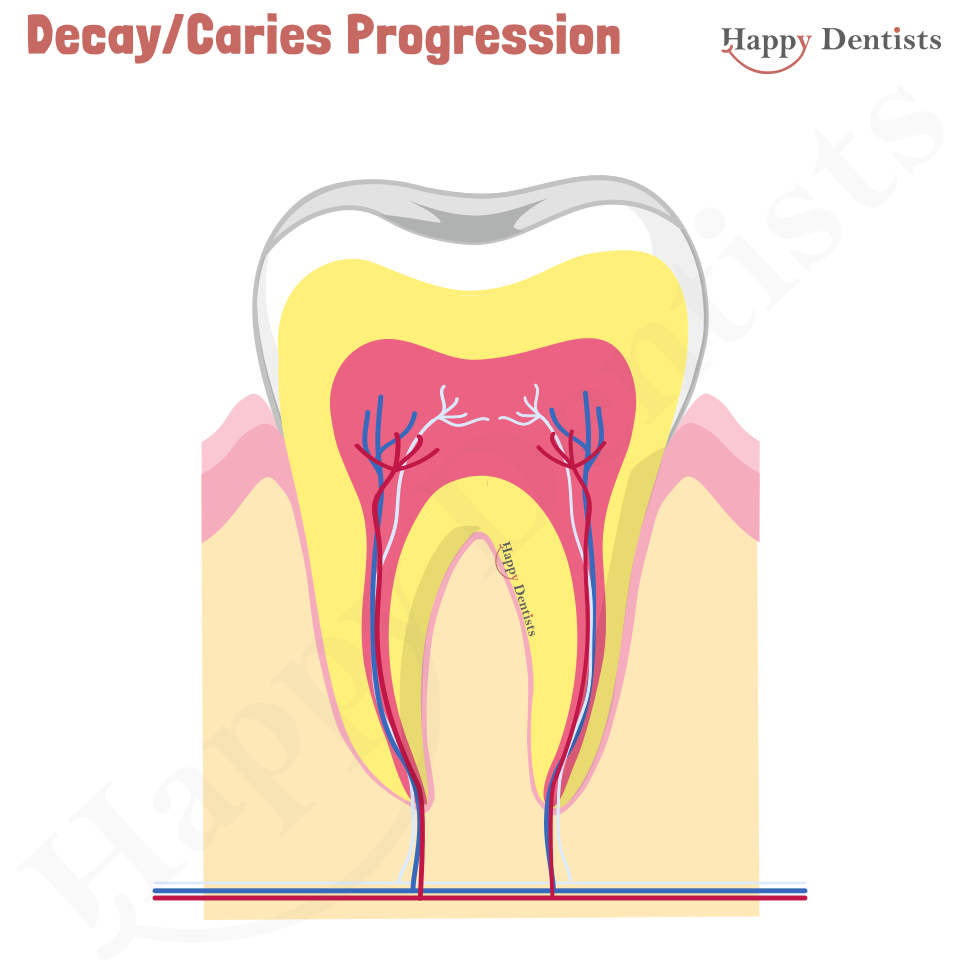Tooth Decay
- Factors Influencing Tooth Decay
- Why do I need a filling if it does not hurt?
- Tooth Restoration Cycle
The type and frequency at which you have sugary foods can influence the amount of the tooth damaging, acid loving bacteria. As long as you feed the bacteria with sugars you will continue encourage decay/caries. Fermentable carbohydrates diffuse into plaque from the oral environment. Not all sugars are equally cariogenic. Complex carbohydrates such as starch are not completely digested in the mouth and have a low cariogenicity. Simple carbohydrates such as glucose and fructose easily diffuse into plaque, are transported into bacterial cells, and have a high cariogenicity. As a result, you should limit your sugary intake of simple carbohydrates.
This is a sticky film containing different bacteria that feed on sugars. Plaque initially adheres to the tooth surface via the acquired pellicle (a collection of adherent proteins on the tooth surface derived from saliva). As the plaque matures, the bacterial composition become more gram-negative and anaerobic. As it grows larger the film becomes more complex and harder to remove. It is important to limit how big the plaque becomes. The biofilm contains bacteria that will create tooth damaging acid.
The mouth is an excellent microbial habitat — it is a warm, moist, nutrient-rich environment with non-shedding hard tissue that penetrates the epithelium. Host factors that affect caries susceptibility includes saliva, tooth morphology, and fluoride exposure. The more caries-susceptible sites are plaque stagnation areas (deep pits and fissures, contact points, and gingival margins), surfaces adjacent to prostheses, and exposed root surfaces. You control what sugary foods you eat and whether you clean away the plaque. You are key at preventing the development and progression of caries. Removing the source and its nutrients is the best way to prevent the disease.
Decay does not occur overnight, it takes time to develop. It is important every time you limit your snacking or clean away the plaque you give your teeth more time.
The usual reason for fixing a hole/caries is to make it easier for you to clean and care for the tooth, with the aim of keeping the tooth for longer. If you leave the caries, you may reduce the treatment options available later. Moving further down the restoration cycle.
It is like knowing you have termites in your already weakened house. Leaving it is likely that more drastic decisions will be required in the future. Removing and repair. Whereas with maintenance and continuous cleaning, you can preserve the house.
It is important to note that there are certain situations where you can leave decay in which the dentist will instruct you on.
Unfortunately restorations/fillings do not last forever and eventually they will have to be replaced. This does not mean you should not get fillings as they are vital in helping to stop progression of decay and aid cleaning.
Your clinician will help you to decide the right options for your situation and stage of the cycle. The point of the tooth life cycle is to understand that cleaning and prevention is important to maintain your tooth’s current state and prolonging the time until you move to the next stage in the cycle.

If you have finished reading all the information on this page, get a certificate for your hard work.
This page provides general information about dental topics. It does not contain all the known facts of this subject and is not intended to replace personal advice from your dentist. If your not sure about anything on this site, contact us or speak to your local oral health practitioner. Make sure you give your local oral health practitioner your complete medical history and dental history.
A selection of the references used:
Fejerskov, O. (2004). Changing paradigms in concepts on dental
caries: consequences for oral health care. Caries research, 38(3),
182-191.
Yip, K., & Smales, R. (2012). Oral diagnosis and treatment
planning: part 2. Dental caries and assessment of risk. British
dental journal, 213(2), 59-66.